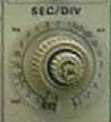

SEC/DIV: Firstly, you should understand what is meant by the CRT Graticule. Secondly, make sure the "CAL" knob is turned fully clockwise as far as it will go; it should remain in this position for every measurement.
The CRT Graticule is divided into 80 divisions. Each division is a square. Along the lines that make up the sides of the square divisions are tick marks that further divide the line lengths into fifths.
The "SEC/DIV" dial determines the time the illuminated dot takes to cross the one Graticule division. If the "SEC/DIV" is set faster than 20ms (meaning 20 milliseconds /division), the dot looks more like a line than a dot.
Play around with the "SEC/DIV" knob until the output you are viewing is of an appropriate width. If you are viewing a DC signal, a small SEC/DIV value (short time per division) is great. If you are viewing a wave and you want to accurately calculate its frequency or the phase difference between two waves then you should have no more than two cycles (periods) of the slowest wave displayed on the screen. If you are measuring the peak amplitude of a wave then you want many waves on the screen so that you can see where the average of their peaks or troughs lie.
The time domain of the trace (the display of the waveform as a glowing curve or line on the screen) is the number of divisions spanning the width of the screen multiplied by the SEC/DIV value.
The Tektronix 2205 is a 20MHz oscilloscope. This is not the maximum sweep rate, rather it is the frequency at which the amplitude displayed on the screen begins to become inaccurate. The maximum sweep rate of the scope is 10MHz, therefore the highest frequency wave that be displayed as only one cycle across the screen is 10MHz.